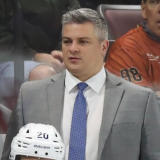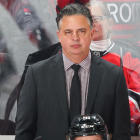
What is most impressive about the postseason success of the Tampa Bay Lightning is how they have been able to win six of their first nine games -- including the first two against the Montreal Canadiens in their second round series -- while getting so little goal scoring production from the top of their lineup.
As of Monday, the Lightning have received just one goal from the duo of Steven Stamkos and Ryan Callahan, their two highest paid players and two-thirds of their top line. They are still one of the highest scoring teams in the postseason averaging 2.78 goals per game after their six-goal outburst in Montreal on Sunday night.
In other words: Depth matters ... a lot.
Having franchise players like Stamkos at the top of your lineup is an essential part of any Stanley Cup recipe, but they are not the only part. You need a deep and balanced lineup that can get offense from any line at any time, and that depth needs to be cheap. Those two points are perhaps just as important as having superstars.
Those franchise players are extremely expensive and take up a significant chunk of a team's salary cap space. Every team that has won the Stanley Cup in the salary cap era has had its five highest paid players take up 41 to 50 percent of its cap space. The Lightning are dedicating 41 percent of their cap space to their five highest paid players this season.
A winning team must be creative when filling out the remainder of its roster and finding secondary production, especially when the free agent market is usually a fool's paradise and trades are nearly impossible because teams are so unwilling to give up young, cheap talent.
This is all especially important because the way the current NHL game is played -- defensive, systematic, great goaltending, more obstruction through the neutral zone -- your star players are not only not going to score every night, they are going to be prone to lengthy scoring slumps throughout the season, a fact that still seems to get overlooked. When a star player goes multiple games without a goal it doesn't necessarily mean there is something wrong with him or that he is playing poorly. If there is a problem it's with the NHL for allowing the game to get to this point where goals are so rare.
Under general manager Steve Yzerman the Lightning have been able to find that necessary depth to pick up the slack when a player like Stamkos goes through a dry spell. And they have done it by going into areas where other NHL teams are at times afraid to go: undersized players, and Russia.
Whether it's part of a larger plan within the Lightning front office or just a fluky coincidence, the Lightning have invested significant resources in the draft to players that fall under one of those two categories (and sometimes both).
It has turned out to be a huge part of their success.
When it comes to the smaller skill players, we already took a brief look at that earlier this season when examining how the league is a lot more welcoming to players that are "undersized" than ever before. Almost no team has benefited more from than than the Lightning.
Their current playoff roster has four players that are 5-foot-11 or shorter and weigh less than 183 pounds (Tyler Johnson, Vladislav Namestnikov, Nikita Kucherov, and J.T. Brown), while a fifth, Ondrej Palat, misses that by group by just one inch in the height department.
Every single one of those players was either drafted by the Lightning (Namestnikov, Kucherov, Palat) or signed as an undrafted free agent (Johnson, Brown) under Yzerman's watch.
The NHL's obsession with size and strength over skill and production in recent decades, especially when it came to the draft, was one of the worst movements in the league when it came to the quality of play on the ice. Skilled, creative players were being overlooked or not given the same opportunity as other players because they were a couple of inches too short or 15 pounds too light.
To be clear, teams shouldn't look to avoid players with size. A big, strong, physical player with skill and production is the ideal player. That's what everybody wants. But there are only so many players that have that perfect combination, and a lot of times what ends up happening is a team falls in love with the the guy that a 6-2, 220 pound power forward frame and ignores the fact the fact he can't score or do anything else other than be big.
For a team that is willing to overlook the lack of size on an otherwise productive player, there is value to be had. If players like Johnson, Palat and Kucherov (who make up one of the best lines in the NHL this season) were a little bit bigger in their draft years, they probably don't fall as far as they did (or in Johnson's case, out of the draft entirely).
When you look at the Lightning's draft record since Yzerman took over in 2010, especially when it comes to forwards, they are mostly smaller, skilled players that were wildly productive at their previous level. Between 2010 and 2013, six of the 13 forwards drafted by the Lightning were shorter than 5-11 and weighed less than 176 pounds at the time of their selection. Three of those forwards already made it to the NHL. Two of them, Kucherov, a second-round pick in 2011, and Palat, a seventh-round pick that same year are regular contributors.
But it's not just their willingness to take undersized, skilled players that pays off.
It's also their willingness to draft Russian players, something that many teams in the NHL are absolutely terrified to do. Some refuse to do it.
Between 2010 and 2013 there were only 37 Russian-born players selected in the NHL draft. The Lightning took five of them. Not only was that more than any other team in the NHL, there were only three other teams in the league that selected more than two over that same time period. The Edmonton Oilers selected four, while the Washington Capitals and Los Angeles Kings both selected three.
There were 12 teams that did not select a single Russian-born player during that four-year stretch.
The concern with Russian players has always been the fear teams would never be able to get them to come to North America, or the that the player would eventually return to Russian to play in the KHL even if they were already playing in North America in the CHL as import players.
Plus, there is no doubt still some belief in some old school hockey minds throughout the league that Russian players are enigmatic floaters that "play when they want to" and aren't the type of players you win with in the playoffs. This year's playoffs, of course, show how ridiculous that belief is.
All of that has led to exceptionally skilled players falling down the draft board and being picked significantly later than they should. But what really stands out about the Lightning's willingness to take Russian-born players is where they are willing to take them. Over that same four-year stretch between 2010 and 2013, the majority of the Russian-born players selected in the draft did not get picked until the final four rounds of the draft. There were only 18 selected in the first round, while only 10 different teams were willing to do so.
The one significant exception, again, has been the Lightning. They selected three of them (again, more than any other team) in the first three rounds of the draft, including two first rounders (Namestnikov and top goaltending prospect Andrey Vasilevskiy).
In 2011 alone they used their first three selections (a first, second and fifth-rounder) on Russians Namestnikov, Kucherov and Nikita Nesterov. Those three players in 2014-15, all playing on entry level deals, combined to score 40 goals for the Lightning.
It's not easy to win a championship or to even seriously compete for one. You need a lot of skill, good coaching, luck, health and your players to be playing their best hockey at the right time of year. It's even harder in a salary cap sport where it becomes impossible to build a consistent championship caliber team because once your players get good, they get expensive. And when they get expensive, you have to say goodbye to some of them.
To maintain that competitiveness year in and year out you need to be able to find value where other teams are not.
Right now there isn't a team in the NHL that seems to be doing a better job of that than the Tampa Bay Lightning. And it's a big reason why they are one of the top Stanley Cup contenders in the NHL.





















